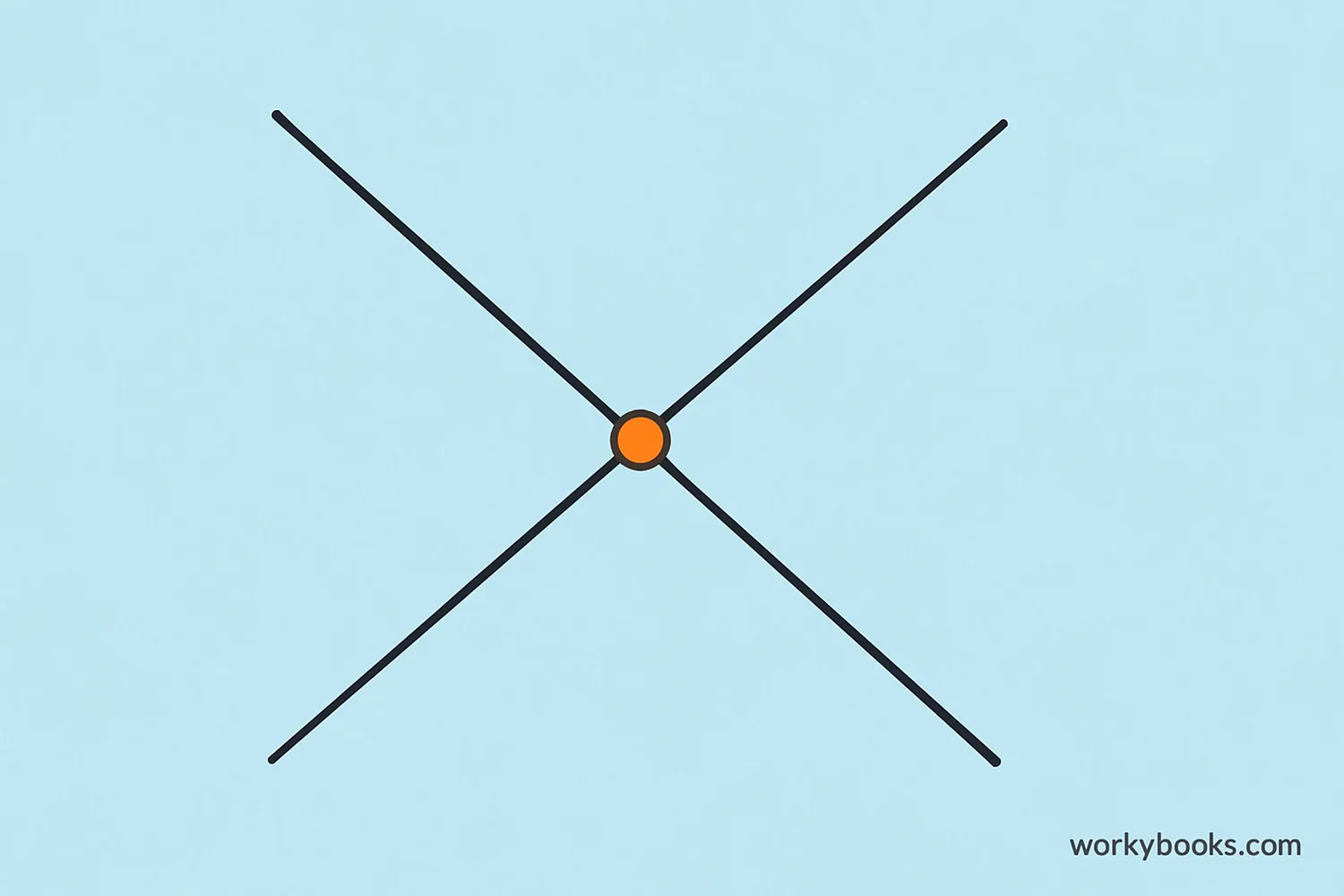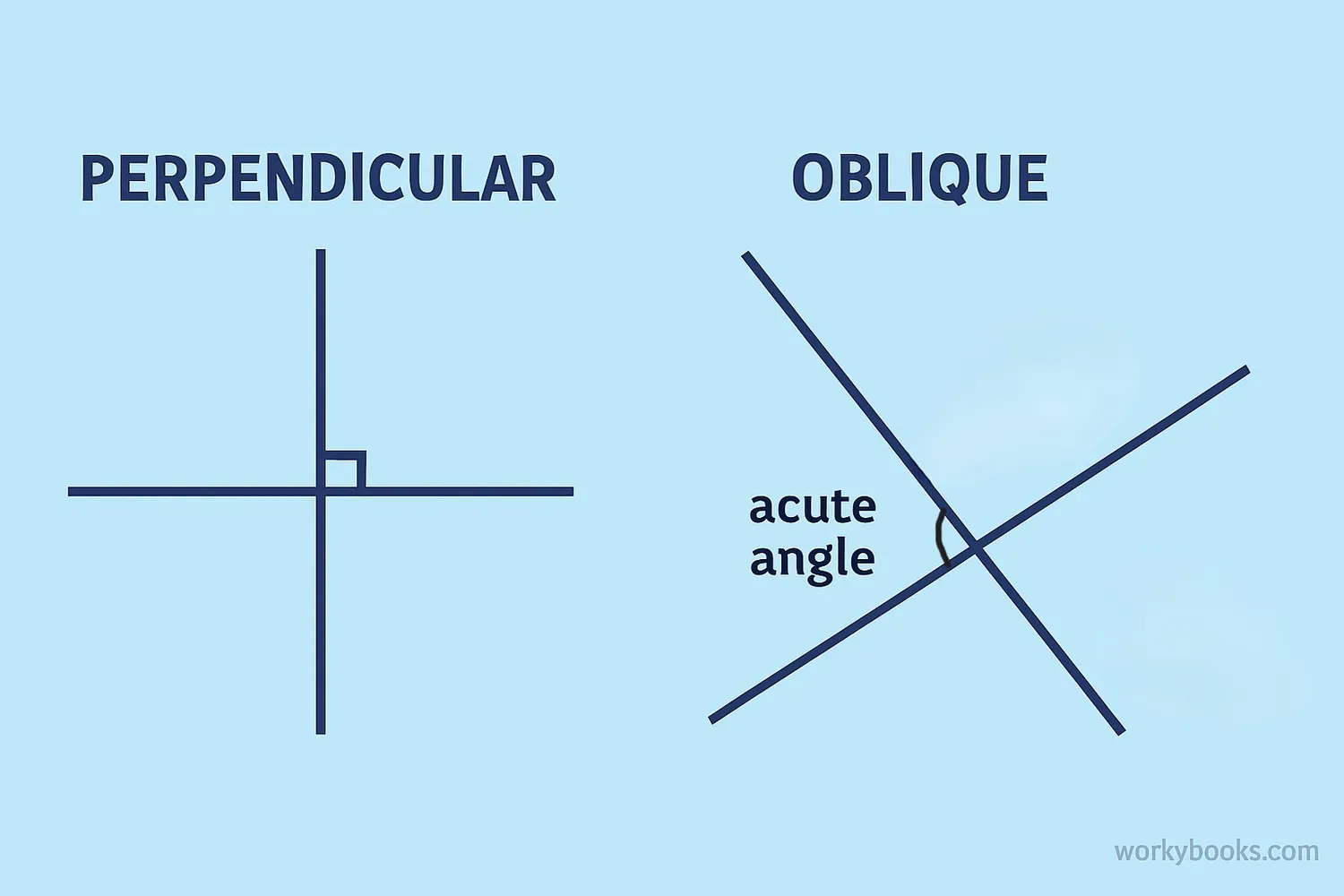Intersecting Lines - Definition, Examples, Quiz, FAQ, Trivia
Learn about lines that cross each other, the angles they form, and their special properties
What Are Intersecting Lines?

Intersecting lines are lines that cross each other at exactly one point. This point is called the point of intersection.
Think of intersecting lines like two roads that cross each other. Where they meet is the intersection. In geometry, lines can cross at any angle, but they always meet at exactly one point if they are straight lines.
Intersecting lines are different from parallel lines, which never cross, and coincident lines, which lie exactly on top of each other.
Key Concept
Intersecting lines always cross at exactly one point, called the point of intersection.
Properties of Intersecting Lines

Intersecting lines have special properties:
1. They cross at exactly one point: No matter how long the lines are, if they're straight and not parallel, they will cross at exactly one point.
2. They form angles: When two lines intersect, they create four angles around the point of intersection.
3. Opposite angles are equal: The angles directly across from each other (called vertical angles) have the same measurement.
4. Adjacent angles add up to 180°: Angles next to each other form a straight line and add up to 180 degrees.
Remember
Intersecting lines always create pairs of equal angles opposite each other.
Types of Intersecting Lines

There are two main types of intersecting lines:
1. Perpendicular Lines: These lines intersect at a right angle (exactly 90 degrees). You'll often see perpendicular lines in the corners of rooms, windows, and doors. The symbol for perpendicular lines is ⊥.
2. Non-Perpendicular Intersecting Lines: These lines cross at any angle that isn't 90 degrees. They form two acute angles (less than 90°) and two obtuse angles (more than 90°), or if they cross at exactly 180°, they wouldn't actually be intersecting lines but the same line.
Special Case: Perpendicular Lines
This notation means Line AB is perpendicular to Line CD, forming 90° angles at their intersection.
Angles Formed by Intersecting Lines
When two lines intersect, they always form four angles. These angles have special relationships:
Vertical Angles: These are the angles opposite each other when two lines intersect. They are always equal. In the diagram, angle 1 equals angle 3, and angle 2 equals angle 4.
Adjacent Angles: These are angles next to each other. They share a common side and vertex. Adjacent angles along a straight line add up to 180°.
Supplementary Angles: Any two angles that form a straight line (adjacent angles) are supplementary, meaning they add up to 180°.
Angle Fact
All four angles formed by two intersecting lines always add up to 360°.
Real-World Examples

Intersecting lines are all around us! Here are some examples:
Roads: When two roads cross each other, they form intersecting lines. A four-way intersection is a perfect example.
Scissors: The two blades of a scissors form intersecting lines that cross at the pivot point.
Window Panes: The frames in many windows form perpendicular intersecting lines.
Plus Sign: The plus sign (+) is made of two perpendicular lines that intersect at their centers.
Letter X: The letter X is formed by two intersecting lines crossing at an angle.
Look around you—can you find more examples of intersecting lines in your classroom or home?
Look Around
Find intersecting lines in your environment. How many can you spot in your classroom?
Intersecting Lines Quiz
Test your knowledge about intersecting lines with this 5-question quiz. Choose the correct answer for each question.
Frequently Asked Questions
Here are answers to common questions about intersecting lines:
Geometry Trivia
Discover interesting facts about geometry and intersecting lines:
Ancient Geometry
The study of lines and angles began over 4000 years ago in ancient Egypt. Egyptians used geometry to measure land after the Nile River flooded each year.
Angle Facts
No matter how two straight lines intersect, the sum of all four angles they form will always be 360 degrees. This is true for any intersecting lines!
City Planning
City planners use intersecting lines to design road networks. Grid patterns with perpendicular intersections make cities easier to navigate.
Nature's Geometry
Intersecting lines appear throughout nature—in spider webs, crystal formations, and even the way tree branches grow and cross each other.





